

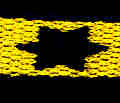

This document was originally written as an instructional pamphlet. It was first distributed at a class I taught during a session of East Kingdom University on 2 May 1992 in the Shire of Quintavia, East Kingdom. (That's a division of the Society for Creative Anachronism, Inc., for those of you who are lost.) Accordingly, the focus of this document is on pre-modern historical European occurrences of the weave and on re-creating the weaves in the context of the SCA. It has been somewhat re-written for web posting, and some additional information has been added on the antiquity of this weave.
This document is provided as is without any express or implied warranties. While every effort has been taken to ensure the accuracy of the information contained, the author assumes no responsibility for errors or omissions, or for damages resulting from the use of the information contained herein.
Permission is granted to make and distribute verbatim copies of this document for non-commercial private research purposes provided the copyright notice and this permission notice are preserved on all copies.
Text and figures © 1992, 1999 Carolyn Priest-Dorman
This pamphlet introduces one period technique for achieving a figured tablet weave. It assumes some basic knowledge of the mechanics and terminology of tablet-weaving. All instructions included herein assume that you have completed at least one tablet-weaving project and that you want to know more about historical techniques of tablet-weaving. You should already know how to read a tablet-weaving draft, number your tablets, correctly thread the tablets and warp whatever kind of loom you use based on the draft, follow a turning sequence, and remove the piece from the loom. It is also assumed that you thread your tablets with the printed side toward the right, with Tablet 1 at the left side of the pack, and that you weave away from yourself.
The term "home position," drawn from the book Step by Step Tablet Weaving, refers to the basic starting point of a sequence of weaving. Specifically, it refers to the position of the tablets wherein holes C and D are closest to the fell (woven part of the piece, as opposed to the as-yet-unwoven part, or warp). In this position holes A and B are closest to the warp. Thus, holes A and D are "up." However, it is important to be aware that not all commercial instruction or draft books rely on this particular interpretation of "home position." Russell Groff's pattern drafts, for example, require beginning with holes A and D closest to the fell. Nevertheless, all the threading diagrams and turning sequences in this pamphlet are predicated on the initial placement of the tablets in "home position."
The term "warp-twined selvedges" refers to selvedges that are executed in plain weave (i.e., continuous forward turning) irrespective of the technique used for the rest of the weaving. They provide firmness and strength to loose weaves such as the double-faced weave technique discussed here. Warp-twined selvedges were an important component of a carefully woven piece in the Middle Ages. Marking or coloring the edges of selvedge tablets helps make it quick and easy to identify them during the weaving of a piece; this is especially useful during the weaving of double-faced bands.
In plain patterned double-faced weaves the tablets are most often threaded with two holes each in two colors; the background tablets are turned in a repeating pattern (two forward, two backward) while the pattern tablets are turned in the reverse pattern (two backward, two forward) in order to bring up patterns. The resulting piece is counterchanged: it displays on its face patterns in one color on a background of the other color, and on its reverse the same patterns appear mirrored, with the opposite color scheme. It is also possible to incorporate more than two colors into a piece, or to produce the same weave without patterning. Some sources refer to this weave as "double-face double-turn." The tablets are often threaded alternately S- and Z-wise in this technique, giving the weave a characteristic alternating bricked appearance. Tablets can also be threaded alternately in sets of two, i.e., SSZZSSZZ, or all in the same direction in order to satisfy different design needs.
Double-face weave that is threaded alternately S and Z is the subject of this document. It makes excellent trim because of its design flexibility. It is possible to weave all sorts of motifs into it--from animals to celestial motifs, human handiworks, heraldic insignia, geometrics, interlacing, and lettering.



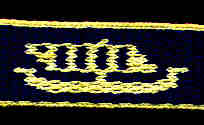
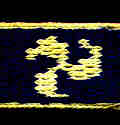

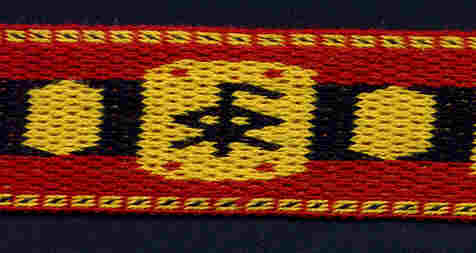
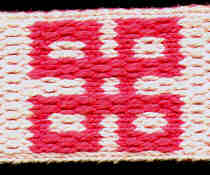

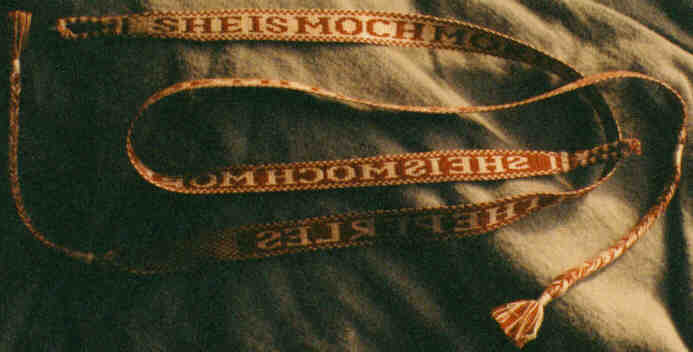
The first known pieces that utilize this technique are two of the tablet woven finds from the Hallstatt period Celtic chieftain's grave at Hochdorf. These bands date to about the late sixth century BCE. Hochdorf Band B alternates areas of 3/1 broken twill double-face weave and areas of alternately threaded double-face weave with the help of tablet idling. The patterns in the non-twill double-face area are horizontal to the weave, i.e., they run across the warp rather than along it or on a diagonal. Hochdorf Band C, a fragment, is threaded SSZZSSZZ and shows a simple diamond-shaped meander pattern in double-weave combined with continuous forward turning (Knudsen, 55-59).
An eighth-century Byzantine tablet-woven band found at Moscevaja Balka at the northwestern end of the Caucasus Mountains (near the Sea of Azov) is worked in Greek lettering (Ierusalimskaja, 251f). Although the write-up isn't clear about the specific tablet-woven technique employed, the photo suggests alternately-threaded double-face weave. The Greek capital letters, with their prominent weftwise ascenders, would not look nearly so crisp in a twill weave.
A later piece, more widely known from its publication in Collingwood, is an unpatterned Egyptian one. Dated to about the tenth century, it displays the characteristic weave structure of alternately-threaded double weave but no woven patterning; instead, it bears an embroidered inscription (Collingwood, 229). Later on this weave also appears in two geometrically patterned Scottish seal tags from about the turn of the thirteenth century; however, both these ribbons are threaded in the same direction (Henshall, 155-59).
The same technique is found in one of the medieval London bands, "Braid 143" (Crowfoot, notes), dating from the mid-fourteenth century. It is a fine, narrow silk band patterned with lozenges.
The finer and more numerous the warp threads, the greater the resolution which is possible in a design of this sort. Depending on the size of thread you use, this technique produces impressive belts, baldrics, trim, straps, ribbons, and even order badges.
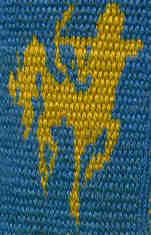
Lord Kormakr the Teeth made an order badge (using about 85 cards threaded with single strands of embroidery floss) that was given out at the Coronation of Balfar I and Luna I in the East Kingdom in October, A.S. XXVI (1991).
Two kinds of drafts are required to weave in this technique: the warping draft and the pattern draft. The warping draft is covered in the next section, "Warping the Loom." But the pattern draft usually needs to be worked out before the warping can be arranged, and this is how it's done. First, choose a design: one of the charges from your device, your favorite animal, a household emblem, a geometric motif, or even your name in runes. Motifs with 45-degree lines work best; those with horizontal and vertical lines work least well but can still be approximated. Your pattern should center on two tablets, although it need not be symmetrical.
Now transfer your pattern to graph paper. Drafts for this technique are drawn on a grid consisting of rectangles: each rectangle represents two throws of weft for one tablet's worth of threads. Draft a pattern on plain graph paper, using a ratio of two vertical squares to each horizontal one. Each vertical square represents one pick of the weft; each horizontal square represents one tablet's worth of threads. See below for three sample drafts; note how each X in each draft covers two square boxes of the graph paper.
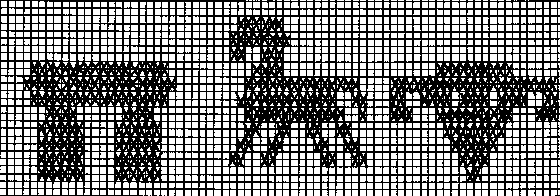
When figuring out how many tablets to warp, first count the number of pattern tablets you have used, then add a multiple of two tablets (two is usually sufficient for a belt- or trim-sized piece) at both sides of the pattern. These extra tablets will help the pattern you weave stand out more clearly by framing it in plain double-face weave of the background color. This gives you the total number of tablets you need to warp in the double-face warping draft. But you should also figure on another multiple of two tablets at each side to make neat warp-twined selvedges. Again, two tablets at each side is generally sufficient unless you have a total pattern of 30 or more tablets; for such pieces, use four tablets or more per selvedge.
Example: You have drafted a pattern that's 18 tablets wide (for instance, the horse motif above). Add to that two tablets at each side of the pattern, for the plain double-face weave "frame"; that gives you 22 tablets. Now add to that two tablets at each side for the selvedges; that gives you a total number of 26 tablets to warp. Tablets 1-2 and 25-26 are warped all in one color, and tablets 3-24 are warped with two colors as noted in the draft below.
Once you have figured out how many tablets you need, then you should number the tablets of your draft, beginning with the two center tablets and working outward toward both ends in order to minimize mistakes.
Starting with your plain warp-twined selvedges, thread all the odd-numbered tablets Z-wise and all the even-numbered tablets S-wise. For the most uniform effect, your selvedges and your weft thread should all be the same color as the background of your piece. All the tablets that are not selvedge tablets should be threaded A and B with the pattern color, C and D with the background color. See the sample draft below.

If you double-check your threading before you start to weave, it will probably save you some headaches. It shouldn't take you more than a minute to thumb through the pack and make sure that
Weave continuously forward for a short while, in order to spread out the threads evenly; you can use a thicker weft for this section if you like. When you're ready to start the double-face, make sure that all the tablets are in home position. Weave two turns forward; you will note that B and C are now uppermost. Next turn the selvedges forward while you turn the other tablets backward for two turns; you will find that A and D have returned to being uppermost. This sequence (two forward, two backward) will be your basic turning sequence. As long as you repeat this sequence, you will get a plain, unusually textured weave which is one color on one side and another color on the other side.
You can begin a pattern whenever the tablets are in home position (or, after you get used to the technique, whenever B and C are up), i.e., after two turns of the tablets in the same direction. When you want to begin a pattern, check to make sure the appropriate holes are uppermost, then refer to your draft to see which tablets need to be moved. Slide all the tablets of the pattern away from you into a second turning pack. Then weave two picks of the normal turning sequence, turning the near pack (background) and the selvedge pack forward; meanwhile, turn the far (pattern) pack backward. The general rule here is that the background pack will always turn in the standard turning sequence (explained in the previous paragraph), while the pattern pack always turns in the opposite direction from the background pack.
You have now completed the first row of your pattern draft--two vertical boxes by one horizontal box on the graph paper. For the second row of your draft, slide all the tablets for the pattern into the far pack, sliding back into the near pack any tablets which return to being background tablets. Then slide the selvedge pack back even with the far pack and weave two more picks, turning the selvedge pack and the far pack forward while you turn the near pack backward. You have now completed the first two rows of your pattern, and your tablets should all be in home position again.
The basic series of activities that is repeated for every two picks of weft in this techniques is this:
While you are learning this technique, it is really very helpful (although not necessary) to always slide your selvedge pack back and forth from near to far to near pack; this process will help you determine which way to turn which pack from row to row of your pattern. Once you have gotten the hang of it, of course, you can keep track in whichever way suits you best.
The pattern you weave will be slightly longer than your draft. The harder you beat, the less out of synch the woven pattern will be with the draft. Drafting on a grid of three-to-one ratio, in order to compensate for this problem, causes even more problems: it's more difficult to draw and it's less intuitive because the turning sequence for this technique is based on units of two, not of three. Additionally, you will wind up with a draft which is longer than the pattern you weave from it.
This technique is suited especially to motifs with diagonal outlines. Weftwise outlines come out rather jagged, and warpwise outlines are slightly wavy. It is possible, however, to get very crisp diagonal outlines. The appearance of the woven pattern will vary slightly from the draft, based on the relative plying of the cords; experience will show you how to capitalize on these variations.
You will make mistakes and have to undo threads from time to time. Just be patient; it's a good learning process.
Recently reissued in paperback, Collingwood's book has a wealth of general comparative information and construction techniques, not all of which are period to the SCA. There is a long chapter section on the S-Z technique in this book.Crowfoot, Elisabeth. Unpublished museum notes on Museum of London Band 143.
These notes were kindly supplied to me by Frances Pritchard.Crowfoot, Elisabeth; Pritchard, Frances; and Staniland, Kay. Textiles and Clothing c.1150 - c.1450. Medieval Finds from Excavations in London, 4. London: Her Majesty's Stationery Office, 1992.
A section of the "Narrow Wares" chapter illustrates and catalogues some tablet weaves, including one in patterned S-Z double-face and one in an unpatterned textural version of the same weave.Henshall, Audrey. "Five Tablet-Woven Seal-Tags." Archaeological Journal, Vol. 121 (1964), pp. 154-62.
Analysis of five very tiny tablet-woven pieces in silk; one is threaded-in, two are double-face, one is 3/1 broken twill double-face, and one is brocade.Ierusalimskaja, Anna A. Die Gräber der Moscevaja Balka: Frühmittelalterliche Funde an der Nordkaukasischen Seidenstrasse, trans. I.M. Smoljanski and Ursula Rosenschon. München: Editio Maris, 1996.
Contains a Greek silk band with a military inscription in double weave.Knudsen, Lise Ræder. "Analysis and reconstruction of two tabletwoven bands from the celtic burial hochdorf," pp. 53-60 in Gisela Jaacks and Klaus Tidow, eds., Textilsymposium Neumünster: Archäologische Textilfunde--Archaeological Textiles 4.-7.5.1993. NESAT [North European Symposium on Archaeological Textiles] 5. Neumünster: Textilmuseum Neumünster, 1994.
This information on the earliest known double-faced tablet weaves is a bit hard to decipher but very useful.Pritchard, Frances. Personal communication (letter to author dated 15th September 1993).
This page was created on 26 February 1997 and last updated on 9 December 1999.
No soliciting! | capriest@cs.vassar.edu